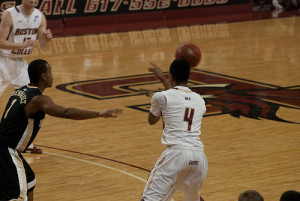5 Common Problems seen during Developmental Passing and Receiving

Passing and Receiving is a vital area of concern for any coach involved in basketball, and to a larger extent sports such as Netball. Passing and receiving form the most utilised fundamental offensive skills within basketball. Therefore, the ability for a player to be able to perform this action is going to be vital in how well a team is able to function overall during its offensive possessions.
There are some common problems to be aware of though, especially for those coaches involved during the developmental phases of a player’s skill growth.
Toes, Nose and Fingers
When executing a pass one of the simplest skills to help a player ensure that their pass results in the greatest accuracy possible, is to focus on that the payer is consistent in three areas of their technique. The first is to have a player always stepping towards their intended target. This helps generate momentum and guarantees a player is lining up their passing lane to the intended receiver as accurately as possible from the ground up.
Secondly, a player should have good sight of the intended target. This will help with the judgement in regards to force needed, but also provide a greater range of vision to see defenders. This teaching point asks that the passers nose points to the intended receiver.
Finally, a passer should utilise a full follow through of the pass finishing with their fingers pointing towards the intended receiver. This will see the last point of contact with the ball pushing towards the target.
Calling Names
A very simple teaching point which can have a dramatic effect on a team’s passing and receiving is improving the communication between players on the court. A passer should always call the name of the player they are passing to, while the receiver should be mirroring the name of the passer. This ensures both players are signalling they are ready and their intentions within the action.
For developing players this teaching point alone will save three or four loose balls a game from passes being made to unsuspecting or not ready teammates.
No Target Hands
Target hands for a receiver help the passer know where their teammate wants the ball. It also shows the passer that the receiver is ready for the pass to be made. A receiver that does not carry their hands to provide a target will always have to work that little bit harder to move into position for the pass. This additional challenge of quicken the reaction needed by the receiver unfortunately in a fast moving games might not be possible and so poor catching position and ultimately loose balls are created.
Not Running through the Line of the Ball
A player who pulls their movement up short and tries to use their arms to over extended to make a catch is not running through the line of the ball. When passing and receiving is working well, the passer will pass the ball out in front of the receiver in the direction of where the intended receiver is heading. This allows the receiver to run onto the ball and not have to slow down.
When a receiver pulls up early to catch a ball they provide an opportunity for the defence to continue on and possibly deflect or steal the ball by sliding through the passing lane. By running through this passing lane, the receiver does not give this opportunity to the defender resulting in a better pass reception more frequently.
Low Stance, Low Centre of Gravity
Struggling to generate power on a pass or loosing balance after making a catch are two very common symptoms of when players fail to assume a low stance. Lowering the centre of gravity helps with balance and this is especially important when passing as in a low stance larger muscle groups from the legs and hips can be activated to help generate power and force into the pass. This principle works in reverse for a receiver, as by being in a low stance during reception of a pass these same muscle groups help stop a player’s momentum, pivot to change direction and then explode to the desired area with greater speed and power.
Passing and receiving are obviously vital skills. Good habits can be created very easily by taking the time to instil the good technical points discussed above during the developmental phase.






Leave a Reply